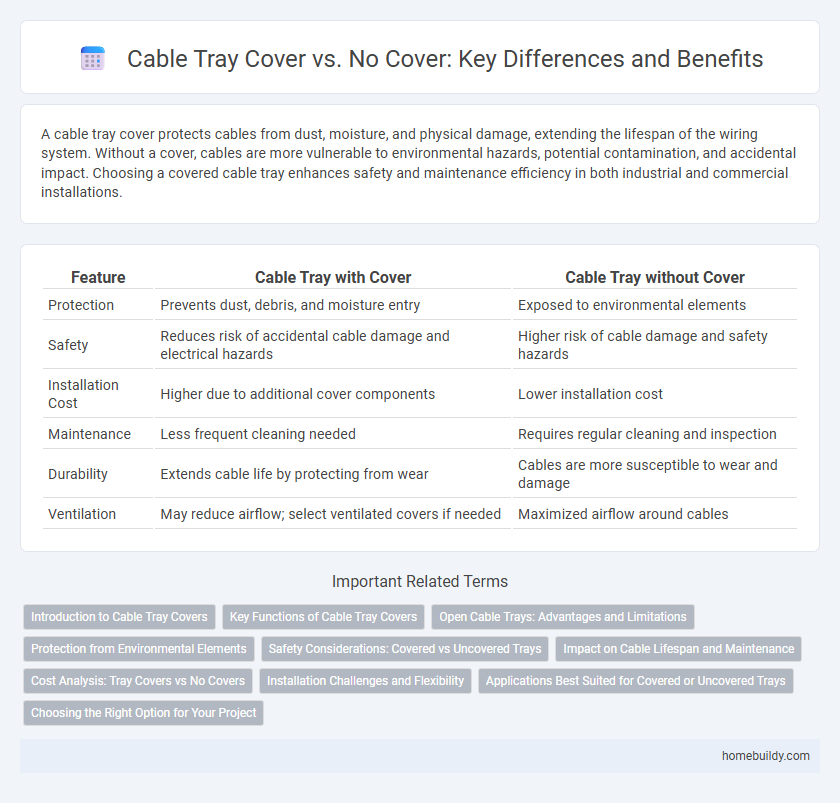A cable tray cover protects cables from dust, moisture, and physical damage, extending the lifespan of the wiring system. Without a cover, cables are more vulnerable to environmental hazards, potential contamination, and accidental impact. Choosing a covered cable tray enhances safety and maintenance efficiency in both industrial and commercial installations.
Table of Comparison
| Feature | Cable Tray with Cover | Cable Tray without Cover |
|---|---|---|
| Protection | Prevents dust, debris, and moisture entry | Exposed to environmental elements |
| Safety | Reduces risk of accidental cable damage and electrical hazards | Higher risk of cable damage and safety hazards |
| Installation Cost | Higher due to additional cover components | Lower installation cost |
| Maintenance | Less frequent cleaning needed | Requires regular cleaning and inspection |
| Durability | Extends cable life by protecting from wear | Cables are more susceptible to wear and damage |
| Ventilation | May reduce airflow; select ventilated covers if needed | Maximized airflow around cables |
Introduction to Cable Tray Covers
Cable tray covers protect electrical cables from dust, moisture, and physical damage while ensuring compliance with safety standards. Covers also help maintain proper temperature control, preventing cable overheating and extending the lifespan of the wiring system. Choosing the right cover material, such as steel, aluminum, or PVC, depends on environmental conditions and installation requirements.
Key Functions of Cable Tray Covers
Cable tray covers primarily protect cables from environmental factors such as dust, moisture, and physical damage, ensuring extended cable lifespan and reliable performance. They also enhance safety by preventing accidental contact with energized cables and reducing the risk of electrical hazards. Moreover, covers aid in organizing cable management systems, providing a cleaner and more secure installation within industrial and commercial environments.
Open Cable Trays: Advantages and Limitations
Open cable trays offer improved air circulation, reducing heat buildup and enhancing cable performance in industrial and commercial installations. They provide easier access for cable inspection, maintenance, and upgrades, lowering downtime and labor costs. However, open trays expose cables to dust, debris, and potential physical damage, requiring strategic placement to mitigate environmental risks.
Protection from Environmental Elements
Cable tray covers provide essential protection against dust, moisture, and other environmental elements, significantly extending the lifespan of cables. Uncovered cable trays leave cables exposed to contaminants that can cause corrosion, insulation damage, and electrical faults. Using covered cable trays is critical in outdoor or industrial settings where environmental exposure is high, ensuring reliable cable performance and safety.
Safety Considerations: Covered vs Uncovered Trays
Covered cable trays provide enhanced safety by protecting cables from physical damage, dust, moisture, and accidental contact, reducing the risk of electrical hazards and fire. Uncovered trays offer easy access for maintenance and heat dissipation but expose cables to environmental factors and mechanical impacts that can compromise insulation integrity and increase safety risks. Selecting covered trays is crucial in industrial or hazardous environments where protection from external elements and personnel safety are paramount.
Impact on Cable Lifespan and Maintenance
Cable trays with covers protect cables from dust, moisture, and physical damage, significantly extending cable lifespan and reducing the frequency of maintenance interventions. Uncovered cable trays expose cables to environmental hazards and mechanical impacts, leading to faster insulation degradation and higher maintenance costs. Implementing covered cable trays enhances overall system reliability and minimizes downtime in electrical installations.
Cost Analysis: Tray Covers vs No Covers
Cable tray covers increase initial installation costs by 15-25% due to material and labor expenses but offer long-term savings through reduced maintenance and decreased damage repair. Uncovered cable trays may lower upfront costs by 10-20% but expose cables to environmental hazards, potentially increasing replacement frequency and downtime expenses by up to 30%. Evaluating total cost of ownership reveals that investing in covers typically reduces lifecycle costs by enhancing cable protection and minimizing operational disruptions.
Installation Challenges and Flexibility
Cable trays with covers provide enhanced protection against dust, moisture, and mechanical damage, but their installation requires additional labor and precise fitting, potentially increasing time and costs. Uncovered cable trays offer greater flexibility during installation and maintenance, allowing quick access for cable modifications or repairs without removing protective elements. Choosing between covered and uncovered trays depends on the environmental conditions and the need for ease of access versus protection in the cable management system.
Applications Best Suited for Covered or Uncovered Trays
Cable trays with covers are best suited for industrial environments where protection from dust, moisture, and physical damage is critical, such as chemical plants and outdoor installations. Uncovered cable trays excel in indoor settings like commercial buildings or data centers where accessibility and ventilation for heat dissipation are prioritized. Selecting between covered and uncovered trays depends on specific application requirements, including environmental exposure and maintenance needs.
Choosing the Right Option for Your Project
Choosing the right cable tray cover depends on the environment and project requirements; covered trays protect cables from dust, moisture, and physical damage, making them ideal for outdoor or industrial settings. Open cable trays allow for better airflow and easier cable access, suitable for indoor installations where cooling and frequent maintenance are priorities. Assessing factors like exposure to contaminants, maintenance frequency, and safety standards ensures optimal cable management and longevity.
Cable tray cover vs no cover Infographic

 homebuildy.com
homebuildy.com